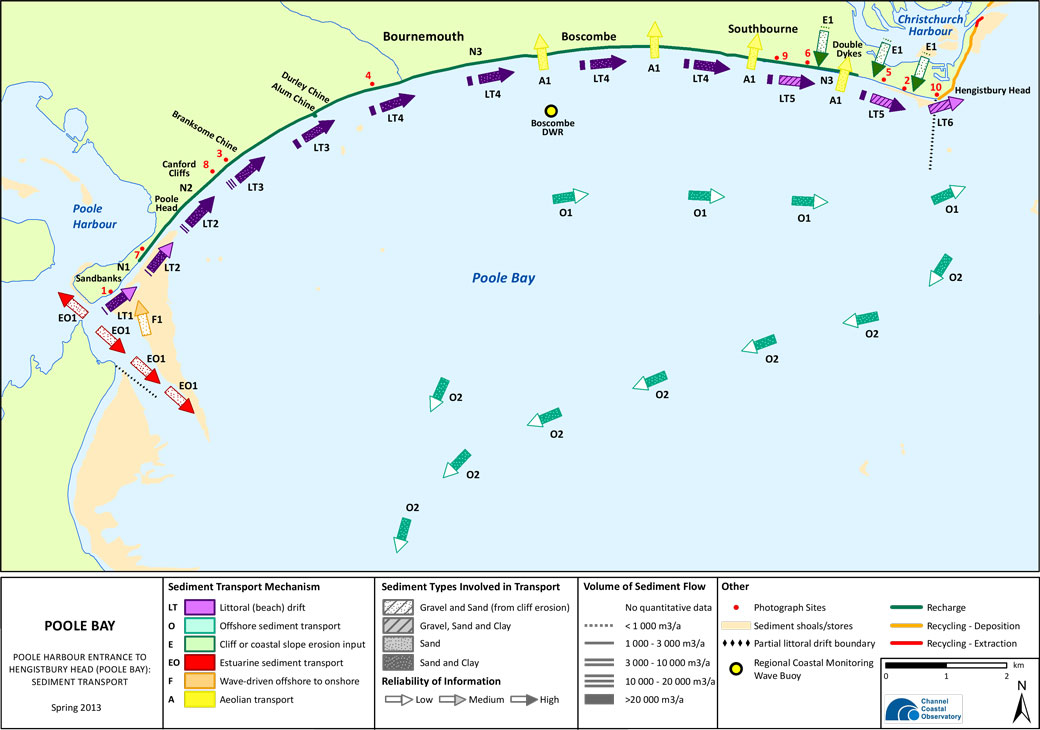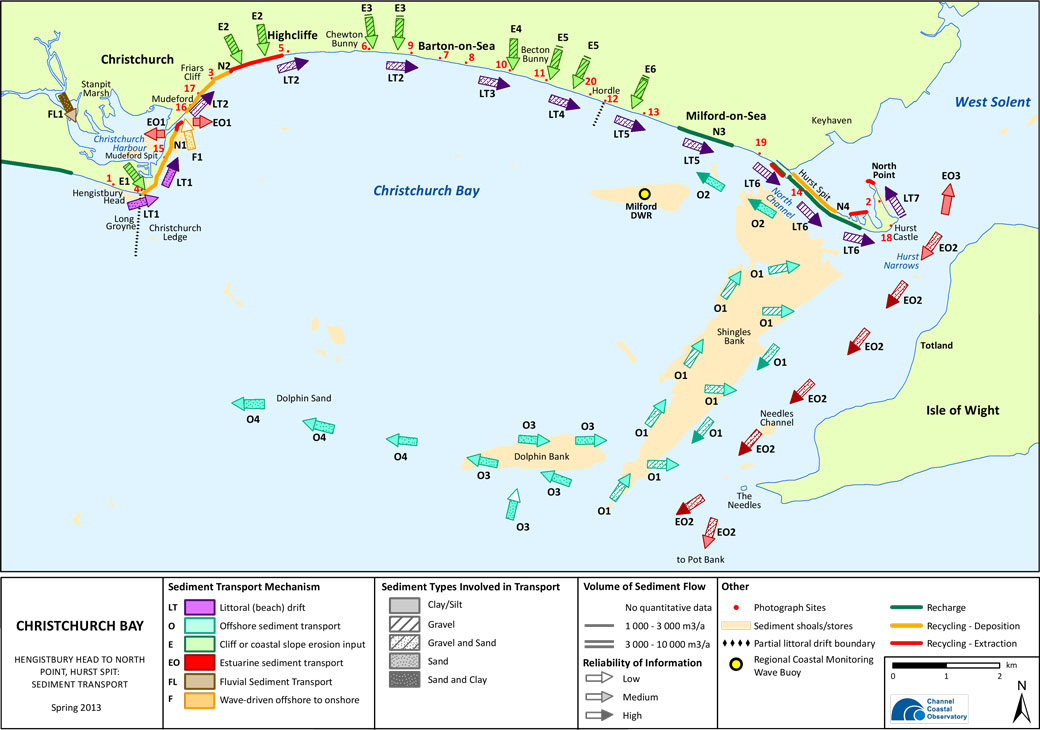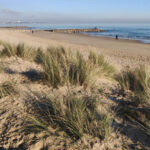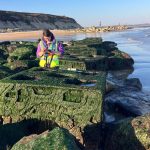Poole Bay Beach Management Scheme
2015-2032A 17-year Beach Management Scheme to protect our coastal frontages, making them more climate resilient.
Timber Groyne renewal winter 2025-2027
Works start October 2025 – read about the project at twobays.net/project/timber-groyne-renewal-winter-2025-27
Background to the Poole Bay Beach Management Scheme
Poole Bay stretches from Sandbanks in the west to Hengistbury Head in the east. Over the last 100 years coastal defence works have included the building of seawalls, construction of a groyne field and the creation and maintenance of an artificially widened beach along this length of coast. In 2011, the Poole and Christchurch Bays Shoreline Management Plan (SMP) set policies to manage the risk of coastal erosion along Poole Bay, through a mostly ‘Hold the Line’ approach over the next 100 years, meaning coastal defences should be maintained and upgraded or replaced in their current position where funding permits.
The ‘Hold the Line’ approach is achieved using a combination of beach replenishment and groynes.
Why beach replenishment?
In Poole Bay the physical protection of the coastline with a sea wall and promenade limits the natural erosion of cliffs which would otherwise top-up beach levels. Cyclic beach replenishment schemes are therefore required to maintain a frontline defence and this requires the use of non-native material. Studies have shown approximately 70,000m³ of sand is lost from the Poole Bay frontage each year.
The beach material is transported by wave action and generally moves eastwards towards Hengistbury Head by a process called longshore (or littoral) drift. Eventually sediment may be transported and deposited further offshore in Poole Bay or into Christchurch Bay.
Why groynes?
As part of the coast protection measures in Poole Bay, groynes are strategically placed to retain the beach material moved by longshore drift. Beaches at Poole and Bournemouth include a variety of groyne types including rock, timber and hybrid structures (constructed from timber with rock on the outer ends) – the former of which have a longer life-span. The combination of groynes with periodic beach replenishment allows the sea walls and cliffs to be better protected.
The current Beach Management Scheme is replacing the life-expired timber groynes along the Bournemouth section of Poole Bay which have a life-span of approximately 25 years.
Sediment Transport (longshore drift) in Poole & Christchurch Bays

Source: SCOPAC Sediment Transport Study 2012, Poole Harbour Entrance to Hengistbury Head. Available at www.scopac.org.uk/sts/poole-bay.html

Source: SCOPAC Sediment Transport Study 2012, Hengistbury Head to Hurst Spit. Available at www.scopac.org.uk/sts/christchurch-bay.html
Project Overview
Beach Management in Poole Bay is designed to provide protection to a significant number of residential and commercial properties. Without it, properties, highways and supporting infrastructure would be lost to coastal erosion.
The Poole Bay Beach Management Scheme will take place over a 17-year period between 2015-2032, and will be carried out in three distinct phases. It is estimated the entire scheme will cost in the region of £50 million, with the majority funded by the Environment Agency.
Overall the aims are to:
- replace Bournemouth’s existing 53 timber groynes, in multiple short phases (based on the life-expiry dates of the structures);
- construct an additional three new timber groynes;
- repair and upgrade Hengistbury Head Long Groyne;
- complete three beach renourishments, approximately once every five years.
Progress timeline
Phase 1 (2015-2020)
Phase 1 of the project was approved by the Environment Agency in October 2015. Government Flood Defence Grant in Aid (FDGiA) and Local Levy funding approval was confirmed in December 2015 with a total scheme cost of £16.8m. A capital contribution of £1.6 million was made by BCP Council.
Assessing the performance of timber groynes at Bournemouth Beach
As part of the timber groyne renewal programme at Bournemouth beach, a study was made into the performance of five ‘experimental’ groynes that had been built between 1985-1987 in order to evaluate the performance of different timber types in the field. Assessments were also made on the feasibility of re-using timber from the deconstructed groynes in the forthcoming renewal programme
Full details and reports available at www.southerncoastalgroup-scopac.org.uk/scopac-research/timber-groynes-performance
Bournemouth Beach Groyne replacement
The first 10 timber groynes replaced from the east of Boscombe Pier by Honeycomb Chine to Fisherman’s Walk, near the zig-zag path
Bournemouth Beach Groyne Replacement
Eight timber groynes replaced eastwards from Fisherman’s Walk to Gordon’s Corner
Bournemouth Beach Groyne Replacement
Twelve timber groynes replaced at Southbourne, from St Catherine’s Path to the eastern end of the promenade. Delivered over a two year period; six groynes in each year
Hengistbury Head Long Groyne, exploratory work
An intrusive condition survey was carried out in May 2019. A number of voids in the underlying foundations were found, with an associated risk of localised failure
For safety reasons the groyne was closed to the public in August 2019, pending further investigation and repairs scheduled for Phases 2/3
Phases 2 & 3 (2020-2032)
In May 2020 the Environment Agency awarded BCP Council £33 million of combined government Flood Defence Grant in Aid (FDGiA) and Local Levy. A capital contribution of £3.3 million by BCP Council was approved in October 2019.
This phase of funding will allow for:
- Replacement of the remaining 26 timber groynes located along the seafront from Southbourne to Alum Chine;
- Two beach renourishments;
- The repair and upgrade Hengistbury Head Long Groyne to ensure the continuation of coast protection for Poole Bay and Christchurch Harbour.
Beach Renourishment
A £7.5 million programme to renourish seven depleted beach areas with approx 350,000m³ of beach material
Beach areas included Solent Path to St Catherine’s Path, Gordon’s zig-zag to Fisherman’s Walk, Boscombe Pier, East Cliff, West Cliff to Middle Chine and either side of Shore Road in Poole; completed March 2021
Timber Groyne Renewal
Five groynes between the Poole/Bournemouth boundary and Middle Chine were deconstructed and replaced with 4 more evenly spaced groynes
Timber Groyne Renewal
Three groynes between Middle Chine and West Cliff zig-zag were deconstructed and replaced with 4 more evenly spaced groynes
Hengistbury Head Long Groyne: investigation works
Ground investigation works were carried out Nov-Dec 2021, the results of which will help inform the design of the planned upgrade of the long groyne. We continued investigations during summer 2022, with underwater surveys and borehole investigations both on land & at sea, using a rotary drilling rig and jack-up barge.
- The long groyne was constructed between 1937–1939; it plays critical role in reducing coastal erosion in Poole Bay and is a stabilising feature for Christchurch Bay
- Exploratory work carried out in 2019 found a number of voids in the underlying foundations of the 82 year old structure, with an associated risk of localised failure.
- For safety reasons groyne access has been closed to the public since August 2019
Timber Groyne Renewal
Four groynes (2 to the east and 2 to the west of Bournemouth Pier) were deconstructed and replaced with 4 more evenly spaced groynes. Work was carried out October 2022 – March 2023
Hengistbury Head Long Groyne: planning application
Late June 2023 a planning application was submitted seeking permission for the repair and upgrade of the Long Groyne to help provide erosion protection for the next 100 years – details of Application No 7-2023-15059-Y can be found at the BCP Planning Portal.
Planning permission was granted in September 2023.
Timber Groyne Renewal
Three existing groynes at East Cliff were deconstructed and replaced with 3 more evenly spaced groynes. Works was carried out October 2023 – February 2024
Hengistbury Head Long Groyne: demolition & construction
On-site preparations started 11 March, with works licensed to take place from April-October 2024. The project included demolition of the existing long groyne, placement of a total of 33,500 tonnes of new rock armour, reuse of salvaged materials wherever possible, and the creation of new marine habitat. Works were successfully completed on schedule in October 2024.
Timber Groyne Renewal, Hengistbury Head beach
Two life-expired timber groynes at Hengistbury Head Beach have been replaced and strengthened with rock at the seaward end. The works made efficient use of machinery and rock already on site for the Long Groyne project.
Timber Groyne Renewal
Starting October 2025, a two-year programme to renew seven life-expired timber groynes between East Cliff and Boscombe Beach.



